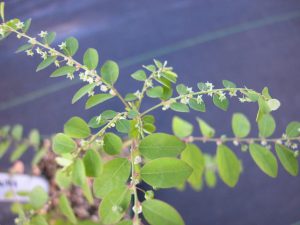Last Updated on September 30, 2020 by Yuvraj
Welcome to Weed Science Wednesday, a weekly series aimed at helping homeowners and horticulture professionals better identify and manage common landscape weeds in Florida.

Credit: Chris Marble, UF/IFAS
The weed of this week is long-stalked phyllanthus (Phyllanthus tenellus). Long-stalked phyllanthus is native to tropical regions in Africa and Asia but has naturalized throughout Hawaii and the southeastern U.S. It is found most often in sunny locations that are irrigated or remain moist. It is a common weed in greenhouses, turf areas, landscape beds, and nursery containers.
Long-stalked phyllanthus is a summer annual weed, but can be seen throughout the year in Florida and may occur as a perennial in southern Florida if frost does not occur. The seedlings typically emerge in late spring and throughout the fall and may begin flowering and producing seed when only a few inches tall.

Credit: Annette Chandler, UF/IFAS
The stems are thin, round, and reddish to brown in color. Leaves are small (1 cm), green, oblong-shaped and alternately arranged. Flowers are star shaped, greenish-white in color, and found on the underside of the leaf axil.
For more information on Long-stalked phyllanthus, including specific recommendations for chemical, physical and cultural weed controls, please consult: Biology and Management of Long-Stalked Phyllanthus in Ornamental Crop Production.
 0
0
